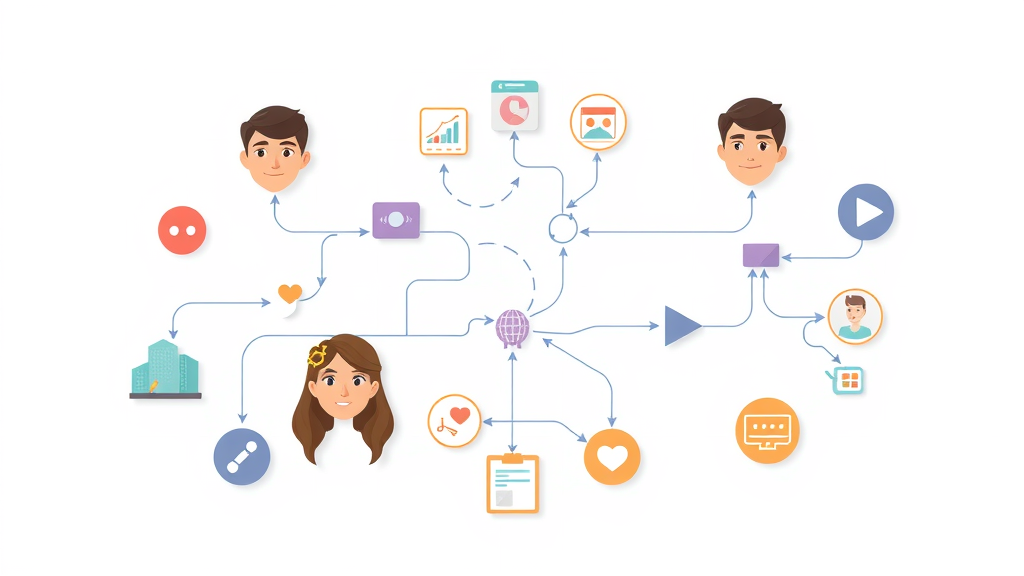Did you know that 87% of top-performing brands supercharge their results with effective cross-channel marketing? In a saturated digital landscape where consumers are everywhere, the secret to real growth lies in seamlessly connecting your marketing campaigns across channels. This in-depth guide reveals the proven tactics you need to transform scattered efforts into a unified channel marketing powerhouse. Whether you're an emerging brand or an established marketer, you'll discover how to reach customers at every stage, drive engagement, and unlock unprecedented business growth with a strategic approach to cross-channel marketing.
Drive Exceptional Results with Cross-Channel Marketing Strategies
Discover how 87% of top-performing brands use cross-channel marketing to outperform their competitors – and how you can too.
Learn the powerful tactics that transform disconnected marketing campaigns into an integrated, growth-driven channel marketing strategy for unmatched reach and customer experience.

Key Insights You'll Gain from This Cross-Channel Marketing Guide
Understand the core principles of cross-channel marketing
Explore practical channel marketing strategies for every business size
Learn to leverage customer data for smarter marketing campaigns
Master the difference between omnichannel, cross-channel, and multichannel marketing
Uncover tools and technologies to improve marketing campaign performance

The Fundamentals of Cross-Channel Marketing
Defining Cross-Channel Marketing in Modern Channel Marketing Ecosystems
Cross-channel marketing is a strategic approach where businesses coordinate their marketing campaigns across multiple digital channels to create a seamless experience for their target audience. Instead of relying on one marketing channel to reach customers, brands can craft a holistic strategy that touches consumers at the moments that matter—whether via social media, email marketing, push notifications, or other digital channels. This approach ensures that each touchpoint reinforces the brand’s message, boosting brand awareness and fostering deeper customer engagement.
In the modern digital marketing landscape, cross-channel marketing involves the purposeful integration of tactics and data across platforms. The goal is not just to be present on multiple channels but to create a unified journey that feels natural and intentional, no matter where or how your audience interacts with your brand. By weaving together email marketing campaigns, social media posts, and push notifications through carefully mapped customer journeys , businesses gain a holistic view of consumer behavior and can optimize each step for conversion.
A powerful cross-channel approach doesn't just increase reach; it amplifies the impact of every marketing effort. Each time your target audience receives a relevant message on their platform of choice, it nudges them further along the journey to make a purchase. With cross-channel marketing, you orchestrate these experiences to maximize both engagement and return on investment.
How Cross-Channel Marketing Differs from Multichannel and Omnichannel Approaches
It’s important to understand the distinction between cross-channel marketing , multichannel marketing , and omnichannel marketing as these terms are often used interchangeably. While all three strategies involve using different marketing channels, the key difference lies in the level of integration and the overall customer experience.
Multichannel marketing involves pushing content through multiple channels, but each channel usually operates in isolation. For example, a business may run a Facebook ad campaign, send out email marketing blasts, and manage a separate website—yet these channels don’t necessarily share data or campaign objectives. In contrast, cross-channel marketing connects these touchpoints, so a customer’s interaction on one platform directly influences their experience on another.
Omnichannel marketing takes the cross-channel approach a step further by focusing on a seamless experience regardless of device or channel. Each channel is not only connected but also adapts in real-time to customer behavior. As a result, omnichannel offers the most cohesive brand experience.
Comparison of Cross-Channel, Multichannel, and Omnichannel Marketing |
|||
Approach |
Features |
Benefits |
Typical Use Cases |
|---|---|---|---|
Multichannel Marketing |
Each channel managed independently; separate strategies |
Broad reach across platforms, easy to start |
Small businesses, single-channel promotions |
Cross-Channel Marketing |
Channels are connected; coordinated messaging and data |
Consistent messaging, increased engagement & conversion |
Product launches, multi-touchpoint lead nurturing |
Omnichannel Marketing |
All channels and devices unified in real time |
Seamless experience, personalized at every touchpoint |
Enterprise retail, e-commerce, advanced customer experience |

Why Cross-Channel Marketing is Essential for Every Marketing Campaign
In an age where the average consumer interacts with a brand across multiple devices and platforms before making a purchase, cross-channel marketing is no longer optional—it's a necessity. By aligning your channel strategies, you ensure that messaging and offers are consistent, relevant, and timely, regardless of how or where your target audience connects with your business.
This approach allows marketers to track the customer journey in real time, attribute success to the right campaigns, and respond to customer behaviors with agility. For example, someone might first see a Facebook ad, sign up for an email list, and later receive a push notification prompting them to make a purchase. Without cross-channel marketing, these marketing campaigns operate in silos, risking wasted spend and missed opportunities for engagement and conversion rate uplift.
Ultimately, businesses that harness cross-channel marketing are better positioned to create memorable, value-driven experiences that foster loyalty and long-term growth. By streamlining your marketing channels and delivering consistent value at every touchpoint, you build a foundation for sustained brand success.
Building a Cross-Channel Marketing Strategy That Converts
Mapping the Customer Journey Across Digital Channels
Identifying key digital channels for effective cross-channel marketing
Understanding the impact of channel marketing and reach customers at every stage
Mapping the customer journey is a foundational step in executing successful cross-channel marketing campaigns. This process begins with identifying the digital channels most relevant to your audience—such as social media, email, website, SMS, and mobile apps. By understanding where and how customers engage, you can design marketing strategies that anticipate their needs and deliver solutions at every step.
A comprehensive customer journey map should detail every interaction point, from the first brand touch on social media to repeat purchases via email marketing or push notifications. Visualizing this journey makes it possible to optimize each channel's role and ensures that no opportunity for engagement is missed. This mapping also highlights the touchpoints where cross-channel efforts can be synchronized for maximum impact, ultimately improving the seamless experience your customers crave.
By tracking behaviors—like which digital channel drives the most engagement or how push notifications influence conversions—you build a data-driven strategy for reaching customers. This data not only informs future content but also lets you personalize messaging, increase conversion rates, and guide users smoothly toward your business objectives.

Leveraging Customer Data to Align Marketing Campaigns
“The brands that excel today are those that use data-driven cross-channel marketing to precisely target the right audience with the right message at the right time.” – Digital Marketing Thought Leader
Harnessing customer data is at the heart of efficient cross-channel marketing. By collecting and analyzing information from each interaction—website visits, social media engagement, email opens, and push notification responses—businesses create a single, holistic view of their audience. This holistic view is invaluable for crafting personalized marketing campaigns that spur action.
The benefits of leveraging customer data are clear: improved segmentation, higher relevance of marketing messages, and increased conversion rates. For instance, analyzing when users are most responsive can inform the timing of push notifications and email marketing campaigns, directly boosting engagement. Additionally, the insights gleaned provide the foundation for a smarter, more adaptive channel marketing approach, where campaigns evolve based on real-world customer behaviors and preferences.
Aligning your marketing campaigns with rich customer data ensures you're always targeting the right audience with the most effective messaging. This not only maximizes your marketing ROI but also Streamlines marketing efforts across multiple channels for superior results.
Target Audience Segmentation and Personalized Interactions
Collecting actionable customer data
Segmenting audiences for personalized cross-channel messaging
Designing user-centric marketing strategies
To unlock the full potential of cross-channel marketing, start by gathering actionable customer data through every touchpoint. Use web analytics, CRM systems, and social media insights to collect detailed profiles. Next, segment your target audience based on demographics, behaviors, interests, and past interactions with your brand. This allows you to create tailored marketing campaigns where each message is relevant and timely.
Segmentation leads to highly personalized marketing experiences. Send specific offers to high-value customers via push notifications, while nurturing prospects through retargeting ads and email marketing sequences. The more tailored your approach, the more likely customers will engage, respond, and ultimately make a purchase.
Designing user-centric strategies means constantly refining your segments as new data becomes available. Over time, this results in stronger audience relationships and more effective marketing strategies that drive both immediate and long-term growth.

Integrating Core Marketing Campaign Channels
Synchronizing Social Media, Email Marketing, and Push Notifications
Best practices for multi-touchpoint digital marketing
Combining email marketing and push notification efforts for maximum engagement
The most effective channel marketing strategies rely on the seamless synchronization of key digital marketing tools. Social media, email marketing, and push notifications each offer unique strengths, but their true value is realized when orchestrated together. For example, an integrated marketing campaign might use a Facebook ad to build awareness, a targeted email marketing sequence to nurture interest, and timely push notifications to prompt action or remind users of special offers.
Best practices involve ensuring each digital channel supports the customer journey, rather than competing for attention. Cross-channel marketing technology solutions can automate messaging, ensuring customers receive consistent, customized experiences at just the right time and place. This approach is proven to increase both engagement rates and brand recall as cross-channel messaging meets customers where they are, across multiple platforms.
To combine email and push notification marketing efforts for maximum engagement, start with a campaign goal—such as boosting sales or re-engaging inactive users. Then, coordinate messages so each channel amplifies the next. For example, send a teaser via email, and follow up with a personalized push notification as a reminder, driving higher cross-channel conversion rates.
Optimizing Each Digital Channel for Cohesive Brand Messaging
Optimization is critical to channel marketing success. Each digital channel must serve a clear role within your marketing strategy and reinforce consistent brand messaging. Start with a unified visual identity and tone of voice so customers recognize your brand whether they encounter a social media ad, an email marketing message, or a push notification. This boosts brand awareness and trust across all touchpoints.
Top brands structure their digital marketing budgets to prioritize the highest-performing channels while supporting emerging ones with targeted tests. The key is to monitor the performance of each marketing channel, learn from analytics, and adapt. For instance, allocate a larger portion of your budget to channels that yield higher ROI — such as retargeting campaigns via email or social media ads—while experimenting with push notifications to support product launches or flash sales.
Cohesion extends beyond visuals. Your messaging should remain consistent but also adapt to the channel's strengths. Rich visuals work well on social media, while personalized content is more powerful in email marketing. The better you harmonize these channels, the stronger your overall marketing campaign results will be.
How Top Brands Allocate Digital Marketing Budgets |
||
Channel |
Typical Budget % |
Main Use Cases |
|---|---|---|
Email Marketing |
30% |
Lead nurturing, promotions, customer retention |
Social Media |
35% |
Brand awareness, engagement, retargeting ads |
Push Notifications |
15% |
Direct engagement, timely offers, app re-engagement |
Other Digital Channels |
20% |
PPC, SEO, SMS, influencer campaigns |
Utilizing Push Notifications in Cross-Channel Campaigns
Push notifications have become one of the most impactful digital channels for engaging users in real time. As part of a cohesive cross-channel marketing campaign, they deliver immediate, actionable content—be it a limited-time offer, a new product alert, or a reminder to complete a purchase. What makes push notifications uniquely powerful is their ability to reach customers directly, cutting through email or social media clutter.
The secret to success with push notifications is context and personalization. Segment your audience to send customized alerts based on previous interactions or shopping behaviors. Balance timeliness and frequency—overuse can cause opt-outs, while well-timed messages drive conversions and keep your brand top-of-mind. For best results, pair push notifications with email and social media campaigns to build momentum, ensuring every customer touchpoint works toward your campaign objectives.

Effective Channel Strategy Coordination for Seamless Marketing Campaigns
Coordinating channel strategy ensures that each part of your marketing ecosystem works synergistically, creating a seamless experience for your audience. This requires clear goals, collaborative tools, and regular cross-functional team meetings. Utilize a central calendar to align campaign launches and touchpoints across all digital channels, minimizing gaps and overlap in your marketing efforts.
The channel approach should prioritize your customer's needs, mapping interactions to the customer journey and adapting based on analytics. For example, if customers tend to discover your brand via social media but convert through email marketing, your strategy should optimize social content for discovery and emails for personalized conversion nudges.
Ongoing communication and transparency between teams—social, email, web, and analytics—prevent siloed marketing efforts and ensure every voice is aligned with the broader strategy. Regular campaign reviews and feedback loops help refine the channel mix and innovate to keep pace with changing digital trends.
Executing and Refining Cross-Channel Marketing Campaigns
Planning and Launching High-Impact Cross-Channel Marketing Campaigns
“Consistency across digital marketing channels amplifies your message and leads to better brand recall.” – Marketing Campaign Specialist
Launching successful cross-channel marketing campaigns begins with disciplined planning. Set clear objectives, define your target audience, and outline which channels will be used at each stage of the campaign. Develop cohesive creative assets and messaging, adapting them to suit each digital platform’s strengths and audience preferences.
A staged rollout—starting with high-reach channels like social media ads, progressing to nurturing emails, and finishing with personalized push notifications—enables you to connect with the audience at different engagement levels. Schedule and automate communications to ensure each touchpoint flows naturally, reinforcing campaign goals at every step.
Establish measurable KPIs for every marketing channel, such as open rates for email marketing or opt-in rates for push notifications. Regularly review performance data so you can make quick adjustments that improve results and ROI.
Maintaining Consistency and Delivering a Unified Customer Experience
Consistency is the connective tissue of any successful cross-channel marketing campaign. Your brand’s design, tone, and value propositions should remain recognizable and reliable whether a customer accesses your Facebook page, opens an email, or receives a push notification alert. This unification cultivates trust, making it easier to guide audiences from curiosity to conversion.
Develop brand guidelines and use marketing automation tools to enforce consistency in scheduling, visual assets, and content format across multiple channels. Empower your teams with updated templates and checklists that ensure messaging harmony. When campaigns feel seamless—regardless of the platform—your customers are more likely to deepen their relationship with your brand and advocate for your offerings.

Real-World Examples of Cross-Channel Marketing Success
Multi-brand cross-channel case studies
Statistics highlighting uplift in customer engagement and ROI
Many leading brands have seen dramatic success by embracing cross-channel marketing. For instance, a retail conglomerate leveraged Facebook and Instagram ads to build holiday anticipation, supplemented by email marketing offering exclusive pre-sale access and followed up with targeted push notifications for last-minute deals. The result? They saw a 40% boost in conversion rate, a unified brand presence, and stronger customer loyalty.
Another example is a SaaS provider using a coordinated approach: nurturing leads via email sequences, prompting product engagement through in-app push notifications, and retargeting prospects on social media with custom offers. By harnessing customer data to calibrate content and timing, they achieved a 25% increase in free-to-paid user conversions and reported improved customer experience feedback.
Industry statistics are equally compelling: according to recent studies, cross-channel campaigns achieve a 24% higher engagement rate and a 30% boost in ROI compared to siloed marketing campaigns. These wins highlight the transformative potential of a systematic, integrated approach.
Metrics to Measure Cross-Channel Marketing Campaign Effectiveness
Customer journey tracking
Conversion rate analysis
Attribution models for channel performance
Measuring the effectiveness of your cross-channel marketing efforts requires sophisticated tracking and analytics. Begin by mapping the entire customer journey —from their first interaction to purchase and beyond. Use analytics tools to identify which channels your customers use at each stage, and which touchpoints have the greatest impact on conversion rates.
Apply conversion rate analysis to compare performance across email marketing, social media, push notifications, and other channels. This allows you to allocate budget more effectively and replicate your most successful tactics. Leverage multi-touch attribution models to understand how different marketing campaigns and channels contribute to final outcomes, ensuring you get an accurate sense of ROI.
With continuous measurement and reporting, you'll be able to refine your approach, optimize future campaigns, and drive ever-better business results.

People Also Ask About Cross-Channel Marketing
What is a cross-channel marketing?
Cross-channel marketing is a strategic approach where brands engage with their target audience across multiple digital channels in a coordinated way to create a seamless and unified customer experience throughout the marketing campaign.
What is an example of a cross-channel?
An example is a customer receiving an email about a new product, following up with a push notification, and seeing a tailored ad on social media—all working together as part of the same marketing campaign.
What is a crossover in marketing?
In marketing, a crossover typically refers to merging elements from different channels, strategies, or campaigns to enhance customer reach and experience—key in cross-channel marketing.
What is cross-platform marketing?
Cross-platform marketing is promoting a consistent message across different devices and channels, ensuring the audience experiences a unified journey regardless of platform.
Overcoming Common Challenges in Cross-Channel Marketing
Aligning Digital Marketing Teams and Technology

One of the most significant obstacles for cross-channel marketing campaigns is aligning diverse digital marketing teams and technologies. Siloed departments or software can lead to inconsistent messaging and fractured experiences. Prioritize frequent collaboration, shared campaign dashboards, and integrated marketing software to ensure all team members have access to customer data and campaign metrics.
Invest in staff training and centralized communication channels, so each marketer understands the complete customer journey and their role in it. Choosing all-in-one marketing platforms that connect social media, email marketing, push notifications, and analytics can simplify this coordination and streamline your marketing efforts.
With clear workflows and smart tools in place, your teams will operate in harmony, shifting quickly to seize new opportunities and refine campaign strategies in real time.
Managing and Unifying Diverse Customer Data
In a cross-channel marketing environment, data is collected from a staggering array of touchpoints—websites, ads, apps, and more. Integrating these disparate sources into a unified view can be daunting, yet it is crucial for effective segmentation and personalization. Use customer data platforms (CDPs) that centralize, clean, and enrich your data, providing a single source of truth for all teams.
Establish strict data governance policies and privacy standards to maintain customer trust and regulatory compliance. Invest in advanced analytics and AI tools to extract actionable insights, so your channel marketing campaigns always target the right audience, with the right message, at the right time.
Ultimately, unified customer data not only optimizes your current campaigns but also empowers continuous innovation across digital channels as consumer expectations evolve.
Adapting Channel Strategy in Evolving Digital Ecosystems

The digital marketing world evolves rapidly—platforms, algorithms, and consumer preferences shift year by year. Successful marketers build agility into their channel strategies, monitoring trends and deploying new tactics as needed. Use real-time analytics to spot emerging opportunities, and foster a company culture that values experimentation and learning in channel marketing.
Respond to changes in how customers use technology: for example, adapt your social media and push notification campaigns to align with new features or consumer behaviors. Regularly A/B test creative elements, email subject lines, notifications, and offers for each channel. This experimentation ensures your marketing strategy remains fresh, effective, and ready to outperform the competition—no matter how the ecosystem develops.
Stay connected to industry thought leaders and prioritize ongoing education and platform certifications to keep your teams on the cutting edge of cross-channel marketing.
Tools and Best Practices to Maximize Cross-Channel Marketing Results
Choosing the Right Digital Marketing Automation Solutions

Marketing automation solutions enable businesses to orchestrate multi-channel campaigns, segment audiences with ease, and deliver timely, personalized messages at scale. Select tools that support automation across social media, email marketing, and push notifications, with seamless data syncing and advanced analytics.
Look for platforms that offer workflow builders, real-time data integration, and customizable reporting dashboards. User-friendly interfaces will let your team launch campaigns faster, while AI-powered features can recommend optimal send times, subject lines, and creative content. Top contenders include HubSpot, Salesforce Marketing Cloud, and Mailchimp, each offering robust support for cross-channel strategies.
The most effective digital marketing automation tools will help you unify your data, centralize campaign management, and create a scalable foundation for long-term growth.
Leveraging Customer Data Platforms (CDPs) for Efficient Channel Marketing
Customer Data Platforms are specialized tools designed to unify, cleanse, and organize vast amounts of marketing data for actionable insights. Implementing a CDP in your cross-channel strategy unlocks powerful audience segmentation, enabling real-time personalization and accurate campaign performance tracking across all marketing channels.
These platforms also support compliance with privacy regulations and allow for better integration with your marketing automation systems, analytics tools, and CRM. The end result is a definitive boost in the quality of your target audience segments, smarter journey orchestration, and increased ROI from your marketing campaigns.
By employing a CDP, brands can break down silos, ensuring every marketing campaign is informed by the most accurate and up-to-date customer data available.
A/B Testing and Continuous Optimization for Marketing Campaigns
Setting A/B test goals
Optimizing content based on performance data
Refining strategies for future cross-channel marketing campaigns
A culture of continuous optimization is essential in cross-channel marketing. Begin by setting clear A/B test goals—such as increasing open rates in email marketing or click-throughs on push notifications. Test everything from headlines and images to send times and calls to action, tracking performance by segment and channel.
Use the insights from these tests to fine-tune your content and execution. Apply winning elements to future campaigns, steadily improving results over time. Pair these efforts with ongoing customer journey analytics and feedback to keep your strategies aligned with evolving consumer preferences and business goals.
The brands that rise to the top are those that never stop testing, learning, and refining their marketing campaigns for ever-stronger results.
Expert Insights: Quotes from Cross-Channel Marketing Leaders
“The future of marketing belongs to those who can orchestrate seamless cross-channel experiences.” – Channel Marketing Director
“Customer-centric channel marketing must leverage data to drive relevance and loyalty across every touchpoint.” – Senior Marketing Analyst
Frequently Asked Questions About Cross-Channel Marketing
How can small businesses implement cross-channel marketing?
Small businesses should start by identifying their most effective digital channels—such as email and social media—then use affordable automation tools and customer data analytics to coordinate messages and measure results.What are the best cross-channel marketing tools in 2024?
The best tools include HubSpot, Salesforce Marketing Cloud, Klaviyo, Mailchimp, and Segment—all supporting integrated campaigns and advanced analytics for channel marketing.How do you measure ROI from a cross-channel campaign?
Use multi-touch attribution, detailed analytics dashboards, and KPIs such as conversion rate, engagement rate, and customer journey completion to gauge the ROI of your marketing campaigns.What industries benefit most from cross-channel marketing?
Retail, e-commerce, finance, SaaS, travel, and hospitality industries gain the most—from complex customer journeys and the need for highly personalized marketing strategies.What trends are shaping cross-channel marketing strategies now?
Increasing integration with AI, real-time data personalization, omnichannel customer experiences, and privacy-centered strategies are defining cross-channel marketing in 2024.
Summary of Proven Cross-Channel Marketing Tactics for Growth
Use customer data for targeted channel marketing
Integrate key digital channels such as email, push notifications, and social media
Measure your marketing campaign results to refine your cross-channel strategy
Focus on consistent messaging for improved customer experience
How Leading Brands Succeed with Cross-Channel Marketing - Case studies, key strategies, and actionable examples illustrated by digital animation and expert narration.
Video Demo: Setting Up Your First Cross-Channel Marketing Campaign
Get step-by-step instruction for configuring your first cross-channel marketing campaign, including best practices for integration, automated triggers, and data tracking.
Leading marketers share tips on refining your channel marketing strategy for better reach, higher engagement, and consistently excellent results.
Ready to Unlock the Power of Cross-Channel Marketing?
Start building integrated, data-driven marketing campaigns today. Take action to align your channel marketing strategies, optimize your customer journey, and accelerate business growth.
Build your cross-channel marketing strategy, integrate your digital channels, track results, and start transforming customer engagement today!
Sources
To deepen your understanding of cross-channel marketing and its impact on business growth, consider exploring the following resources:
Is your Marketing Limping Along? Would you like your strategies to Work Together Seamlessly and Effectively? Click the link and Download the “The Ultimate Small Business Cross-Channel Marketing Checklist”
“Cross-Channel Marketing Strategies to Boost Ecommerce Sales” ( mailchimp.com )
This article delves into the benefits of cross-channel marketing for e-commerce businesses, highlighting how integrating multiple channels can enhance customer engagement, improve brand recognition, and increase conversion rates.
“A Complete Guide to Cross-Channel Marketing” ( airship.com )
This comprehensive guide provides insights into the fundamentals of cross-channel marketing, offering practical strategies and best practices to create a seamless customer experience across various platforms.
By exploring these resources, you’ll gain valuable insights into implementing effective cross-channel marketing strategies that can drive customer engagement and business growth.
 Add Row
Add Row  Add
Add 




Write A Comment